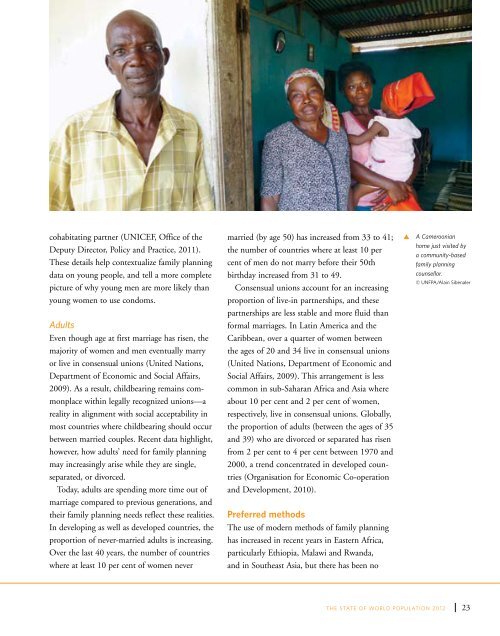State of World Population 2012 - Country Page List - UNFPA
State of World Population 2012 - Country Page List - UNFPA
State of World Population 2012 - Country Page List - UNFPA
Create successful ePaper yourself
Turn your PDF publications into a flip-book with our unique Google optimized e-Paper software.
cohabitating partner (UNICEF, Office <strong>of</strong> the<br />
Deputy Director, Policy and Practice, 2011).<br />
These details help contextualize family planning<br />
data on young people, and tell a more complete<br />
picture <strong>of</strong> why young men are more likely than<br />
young women to use condoms.<br />
Adults<br />
Even though age at first marriage has risen, the<br />
majority <strong>of</strong> women and men eventually marry<br />
or live in consensual unions (United Nations,<br />
Department <strong>of</strong> Economic and Social Affairs,<br />
2009). As a result, childbearing remains commonplace<br />
within legally recognized unions—a<br />
reality in alignment with social acceptability in<br />
most countries where childbearing should occur<br />
between married couples. Recent data highlight,<br />
however, how adults’ need for family planning<br />
may increasingly arise while they are single,<br />
separated, or divorced.<br />
Today, adults are spending more time out <strong>of</strong><br />
marriage compared to previous generations, and<br />
their family planning needs reflect these realities.<br />
In developing as well as developed countries, the<br />
proportion <strong>of</strong> never-married adults is increasing.<br />
Over the last 40 years, the number <strong>of</strong> countries<br />
where at least 10 per cent <strong>of</strong> women never<br />
married (by age 50) has increased from 33 to 41;<br />
the number <strong>of</strong> countries where at least 10 per<br />
cent <strong>of</strong> men do not marry before their 50th<br />
birthday increased from 31 to 49.<br />
Consensual unions account for an increasing<br />
proportion <strong>of</strong> live-in partnerships, and these<br />
partnerships are less stable and more fluid than<br />
formal marriages. In Latin America and the<br />
Caribbean, over a quarter <strong>of</strong> women between<br />
the ages <strong>of</strong> 20 and 34 live in consensual unions<br />
(United Nations, Department <strong>of</strong> Economic and<br />
Social Affairs, 2009). This arrangement is less<br />
common in sub-Saharan Africa and Asia where<br />
about 10 per cent and 2 per cent <strong>of</strong> women,<br />
respectively, live in consensual unions. Globally,<br />
the proportion <strong>of</strong> adults (between the ages <strong>of</strong> 35<br />
and 39) who are divorced or separated has risen<br />
from 2 per cent to 4 per cent between 1970 and<br />
2000, a trend concentrated in developed countries<br />
(Organisation for Economic Co-operation<br />
and Development, 2010).<br />
Preferred methods<br />
The use <strong>of</strong> modern methods <strong>of</strong> family planning<br />
has increased in recent years in Eastern Africa,<br />
particularly Ethiopia, Malawi and Rwanda,<br />
and in Southeast Asia, but there has been no<br />
t<br />
A Cameroonian<br />
home just visited by<br />
a community-based<br />
family planning<br />
counsellor.<br />
© <strong>UNFPA</strong>/Alain Sibenaler<br />
THE STATE OF WORLD POPULATION <strong>2012</strong><br />
23
















